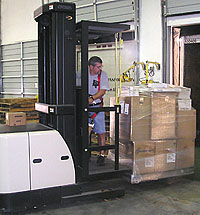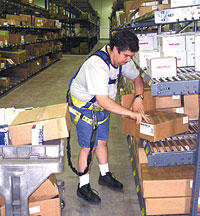
These parts suppliers are also trying to define next year's replacement parts needs as the production of 13-SEER minimum-efficiency unitary products becomes mandatory.
According to Gary Wenzel, Trane's marketing manager for parts, "Our residential OEM side rolls out the 13-SEER systems. Parts lists are created and generated for us before the equipment sells." They will also continue to maintain parts for lower-efficiency systems.
"I think everybody in the industry believes the parts business will increase because of the 13 SEER legislation next year," said Don Harter, general manager of the Rheem Air Conditioning Replacement Parts Department. "Obviously if you have a compressor go out today, customers will replace the condensing unit. Next year they may not want to," due to the potentially higher cost of the condensing unit.
"The higher-efficiency system will not work properly going with an 8- or 10-SEER indoor unit," Harter said. "That doubles the cost of the replacement."
More compressors may be replaced instead of condensing units. In the end, compressors and coils will be the main replacement items, said Harter.
"It could influence the buying decision of replacing the condensing unit vs. not replacing it. Coils will need to match up to existing units out there. We do anticipate some increase," he said.
How much of an increase? "We're wrestling with that as we speak," he said. "We'll go into the summer next year cautiously, with a little heavier inventory."
Frank Kern believes the industry is trying to determine if it is going to see a shift to more repair and maintain than replace because of the new, higher front-end cost. "We'll maintain parts levels to maintain the equipment that we sell," said the director of York's Source 1. "I'm not sure contractors know the move is on by all manufacturers to educate contractors.
"I don't think that we're seeing a significant change in attitude among contractors. It depends on the sophistication of the contractor, whether he's more comfortable selling replacement equipment vs. the contractor who is more comfortable selling repair jobs."
Counter Intelligence
Contractors and service technicians know full well the value of having counter staff who know enough about the systems to be able to be helpful. They have often reported a lack of knowledgeable people behind the counter to groups such as the Heating, Airconditioning & Refrigeration Distributors International (HARDI). HARDI now offers counter staff training and certification for its members: the Counter Recognition program (www.hardinet.org)."We have requirements for our people internally," said David Coghlan, global parts leader, Trane. "There is a set of courses for new hires. As they become more experienced, they will walk up a staircase of courses so they can become as expert as they can be."
In addition, product databases "help a customer move from a unit to individual parts to fix that piece of equipment," he said.
"Technical support lines are available so if somebody comes in with a weird piece of equipment, they can find the parts for it. No matter how expert an associate might be, there is still something they might not know."
A new system also will gradually be implemented in all Trane outlets, "that will provide much more information to our counter people," Coghlan said. "If you look at this from the consumer world, this might not be a major leap ahead. For our industry, it's a major leap ahead. It helps them identify parts that they might not have but that another store has.
"If a tech walks into one store in Atlanta and asks for a quote but later in the day walks into another store in Atlanta, he can complete the transaction in the second store. Which store gets the sale isn't as important as that the customer was served," Coghlan said.
Dave Westbrook, Southeast Michigan parts manager for Trane, gets a lot of his counter help from among the legions of service techs who are tired of crawling up on rooftops. "They get to go to work at the counter," he said. "The guy behind the counter is our differentiation. They have the contact with those customers every day.
"There are certain expectations from service techs, such as product knowledge. Every day is different. You're exposed to learn something new every single day."
The York Source 1 parts division said it has likewise stepped up its efforts to provide better service to its customers. "The general concept is to provide excellent service at the point where most HVAC contractors have the most face-to-face contact with their suppliers - at the parts counter." The goal is to build long-term relationships that will build more business, "similar to building relationships through service agreement sales for a contractor," the company said.
The Source 1 VIP (Verifying Information on Parts) program also helps distributors, dealers, and service techs identify and verify replacement parts for Unitary Products Group (UPG) products. The database includes the UPG parts list catalogs from the past 17 to 25 years, the company said.
VIP provides information about the contractor's company and customers; compressor substitution information; drawing views of products; export data for use by another application; filter models, parts, or accessories that can be identified by partial or complete part numbers, type, description, or vendor numbers; order forms to enter and track orders; a parts inquiry to look up parts by number, type, description, or vendor number; product parts lists; quick part lookup; and a lookup of parts that have been or could be used as a replacement for a part.
Online literature is very well rounded at Carrier's Totaline Web site (www.totaline.com). Technical data is available on coils, commercial applied products, compressors, HVAC supplies, indoor air quality (IAQ) products, motors and electrical accessories, refrigerant recovery tools, refrigeration parts, thermostats, and tools and instruments. There are also owner's manuals and guides, including Totaline, Carrier, and Bryant thermostats, plus thermostat submittal sheets.
Carrier's online resources also include distributor links, distributor shipment tracking, corporate links, Electronic Parts Information Catalog (EPIC) and material safety data sheet (MSDS) information, an order center, trade site, and a dealer locator. In addition, there are more than 700 Totaline outlets to date.

Parts Expansion
Refining, defining, and expanding parts lines is an old and ongoing puzzle for HVACR parts providers. Availability likewise is continually re-examined.Carrier's Replacement Components Division's Totaline Network provides access to more than 120,000 parts. The company's branded HVACR parts "are designed to fit and service any brand of equipment," the company said. It's the only source for authorized semi-hermetic Carlyle and Totaline compressors, has direct replacement parts for Carrier and Bryant equipment, and offers product lines from top suppliers under the supplier's brand name.
"We have implemented demand-flow replenishment to manage inventory in the stores," Trane's Coghlan said. "Instead of store management, we use inventory management experts and systems to develop stocking.
"The other part of availability is looking at our existing stores and making sure opening and operating hours suit our customers. Parts centers open early depending on the market," he said. "Starting times in New York are going to be a bit later than in the Midwest."
The Southeast Michigan warehouse coordinates parts runs for all three stores managed by Westbrook. The stores share parts - if one of the outlets needs a particular compressor and another outlet has it, the first outlet can relinquish it for the good of the customer. "We're always going to share inventory."
According to Rheem's Harter, "We're expanding our lines, adding products such as whole-house HEPA filters, energy recovery ventilators (ERVs), UV lights, and different kinds of filtration systems. ERVs are still pocketed in regions of the country," he added. "There are ERVs and heat recovery ventilators (HRVs), which have considerable use up in the Midwest."
He also sees more of an in-crease in pleated media, such as 4- and 5-inch pleated filters. "More are installed on new installations," Harter said. "If you put in the 4-inch media filter and you wanted to upgrade to an electronic air cleaner, you could do that."
Rheem moved its entire Re-placement Parts Department from the company's headquarters in Fort Smith, Ark., to Randleman, N.C., to become more centrally located for its customer base. When it comes to parts delivery, time can mean everything, and being physically closer is a big plus.
"It's working out very well," said Harter, who said the move was first determined by lack of space in the Fort Smith location. "North Carolina is a good logistical center for most of our customers."
The facility, whose construction was announced last year, has 180,000 square feet. According to the manufacturer, "The Fort Smith location delivers a 41-percent [parts] market reach." The new parts distribution center, on the other hand, is central to 85 percent of the company's current and projected market demand. In addition, Federal Express will be opening a major sorting and shipping hub in Greensboro, N.C. - a boon for distribution.
York's Source 1 also opened a 200,000-square-foot headquarters warehouse in Wichita, Kan.

Feedback
These parts distributors have come a long way in their own ways. "We've had some very positive feedback from customers in a number of ways," said Coghlan."They see us as more of a one-stop shop. They're recognizing the fact that we're opening new locations. They're seeing the benefits of the investments we've made in adding new people and training existing staff.
"Our customers expect parts immediately. There are always times when you can't provide the part as quickly as they'd like. Also, customers don't want to travel more than 20 minutes to get it. We have come a long way, but we have demanding customers who in turn have demanding customers."
"This is the area where the customer comes to us," added Westbrook. "This is our house."
Publication date: 08/22/2005



